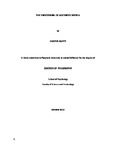The Processing of Accented Speech
| dc.contributor.supervisor | Goslin, Jeremy | |
| dc.contributor.author | Duffy, Hester Elizabeth Sarah | |
| dc.contributor.other | Faculty of Science and Engineering | en_US |
| dc.date.accessioned | 2013-07-08T10:57:38Z | |
| dc.date.available | 2013-07-08T10:57:38Z | |
| dc.date.issued | 2013 | |
| dc.identifier | 10255270 | en_US |
| dc.identifier.uri | http://hdl.handle.net/10026.1/1556 | |
| dc.description.abstract |
This thesis examines the processing of accented speech in both infants and adults. Accents provide a natural and reasonably consistent form of inter-speaker variation in the speech signal, but it is not yet clear exactly what processes are used to normalise this form of variation, or when and how those processes develop. Two adult studies use ERP data to examine differences between the online processing of regional- and foreign-accented speech as compared to a baseline consisting of the listeners’ home accent. These studies demonstrate that the two types of accents recruit normalisation processes which are qualitatively, and not just quantitatively, different. This provided support for the hypothesis that foreign and regional accents require different mechanisms to normalise accent-based variation (Adank et al., 2009, Floccia et al., 2009), rather than for the hypothesis that different types of accents are normalised according to their perceptual distance from the listener’s own accent (Clarke & Garrett, 2004). They also provide support for the Abstract entry approach to lexical storage of variant forms, which suggests that variant forms undergo a process of prelexical normalisation, allowing access to a canonical lexical entry (Pallier et al., 2001), rather than for the Exemplar-based approach, which suggests that variant word-forms are individually represented in the lexicon (Johnson, 1997). Two further studies examined how infants segment words from continuous speech when presented with accented speakers. The first of these includes a set of behavioural experiments, which highlight some methodological issues in the existing literature and offer some potential explanations for conflicting evidence about the age at which infants are able to segment speech. The second uses ERP data to investigate segmentation within and across accents, and provides neurophysiological evidence that 11-month-olds are able to distinguish newly-segmented words at the auditory level even within a foreign accent, or across accents, but that they are more able to treat new word-forms as word-like in a familiar accent than a foreign accent. | en_US |
| dc.language.iso | en | en_US |
| dc.publisher | University of Plymouth | en_US |
| dc.subject | Cognition | |
| dc.subject | Accent | |
| dc.subject | ERP | |
| dc.subject | Developmental | |
| dc.subject | Electrophysiology | |
| dc.subject | Speech processing | en_US |
| dc.title | The Processing of Accented Speech | en_US |
| dc.type | Thesis | |
| plymouth.version | Full version | en_US |
| dc.identifier.doi | http://dx.doi.org/10.24382/3232 |
Files in this item
This item appears in the following Collection(s)
-
01 Research Theses Main Collection
Research Theses Main


